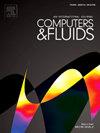Semi-implicit quasi-Lagrangian Voronoi approximation for compressible viscous fluid flows
IF 2.5
3区 工程技术
Q3 COMPUTER SCIENCE, INTERDISCIPLINARY APPLICATIONS
引用次数: 0
Abstract
This paper contributes to the recent investigations of Lagrangian methods based on Voronoi meshes. The aim is to design a new conservative numerical scheme that can simulate complex flows and multi-phase problems with more accuracy than SPH (Smoothed Particle Hydrodynamics) methods but, unlike diffuse interface models on fixed grid topology, does not suffer from the deteriorating quality of the computational grid. The numerical solution is stored at particles, which move with the fluid velocity and also play the role of the generators of the computational mesh, that is efficiently re-constructed at each time step. The main novelty stems from combining a quasi-Lagrangian Voronoi scheme with a semi-implicit integrator for compressible flows. This allows to model low-Mach number flows without the extremely stringent stability constraint on the time step and with the correct scaling of numerical viscosity. The implicit linear system for the unknown pressure is obtained by splitting the reversible from the irreversible (viscous) part of the dynamics, and then using entropy conservation of the reversible sub-system to derive an auxiliary elliptic equation. A remapping phase based on Lloyd iterations is applied to improve the mesh quality, while preserving the Lagrangian paradigm as much as possible. The final method, called SILVA (Semi-Implicit Lagrangian Voronoi Approximation), is validated in a variety of test cases that feature diverse Mach numbers, shocks and multi-phase flows.
求助全文
约1分钟内获得全文
求助全文
来源期刊

Computers & Fluids
物理-计算机:跨学科应用
CiteScore
5.30
自引率
7.10%
发文量
242
审稿时长
10.8 months
期刊介绍:
Computers & Fluids is multidisciplinary. The term ''fluid'' is interpreted in the broadest sense. Hydro- and aerodynamics, high-speed and physical gas dynamics, turbulence and flow stability, multiphase flow, rheology, tribology and fluid-structure interaction are all of interest, provided that computer technique plays a significant role in the associated studies or design methodology.
 求助内容:
求助内容: 应助结果提醒方式:
应助结果提醒方式:


